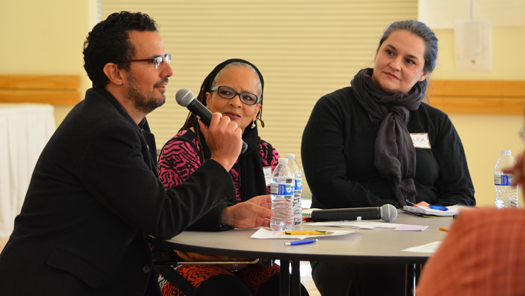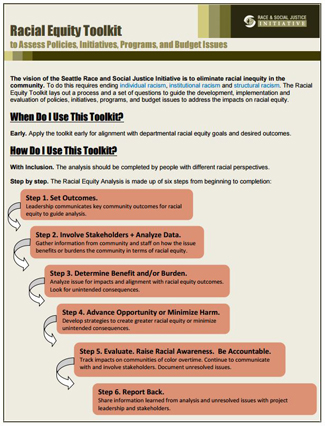Valuing Diversity, We Strive for Racial Equity and Social Justice

Last month, I had the pleasure and the privilege of being part of a panel addressing the role that racial equity and social justice play in government programs and funding in front of the Aging and Disability Services’ Advisory Council. My fellow panelists, pictured above, were Matias Valenzuela, director of the King County Office of Equity and Social Justice (left) and Deborah Terry-Hayes, a well-known local educator and community organization leader (center).
Each of us brought a different perspective on the topic, including our lived experiences and family histories. Our audience brought their engagement, curiosity, and a desire to know more about this important topic. My task was to talk about how racial equity and social justice manifest in the work of government as a funder of services.
First, a little background—I am an immigrant. I am perceived as white. When I came to the United States some 26 years ago, I had no clear idea of what that meant or that it meant anything at all. It took 10 years of living here for me to realize that being white meant something very tangible.
My path navigating education, immigration processes, employment opportunities, advancement opportunities, health care, even shopping, was made smoother, easier, and more accessible because I was white and able to blend in. I could not ignore that immigrants of color were not accepted and treated in the same way as I was. I could not ignore that my relationships with people of color in general, no matter how much we otherwise had in common, kept running into an invisible wall.
In 1998, I became a refugee resettlement case worker at a local nonprofit organization. I would continue in that position for many years and personally help resettle over 600 refugees from all over the world. While working with refugees and immigrants, I became aware of the City of Seattle’s Race and Social Justice Initiative and had opportunities to participate in workshops and community trainings organized by Seattle’s Human Service Department (HSD) staff. This was the point at which I began to work intentionally on understanding the meaning of race and the impacts of racial inequity in the United States, and examined whiteness and the systems that maintain the privileges of whiteness.
A big part of my decision to join Aging and Disability Services in 2012 was the opportunity to be part of HSD’s racial equity work. In 2014, I joined the dedicated staff on the Race and Social Justice (RSJ) Change Team.

The City of Seattle uses a Racial Equity Toolkit to assess policies, initiatives, programs, and budget issues.
Human Services Department staff have been on the forefront of racial equity work in the communities we serve for over 25 years. Today, we do so in a variety of ways. Our department has adopted an outcome-based framework for the services and funds we contract to serve the community, which includes racial equity goals for all processes. HSD’s RSJ Change Team and the Senior Leadership Team are engaged in conducting an analysis of our power as a major funder, our effectiveness as stewards of public dollars, and the impact we have on the community we serve, both positive and negative. An important part of this analysis is establishing what circular accountability looks like for our department and establishing authentic ways to engage the community in shaping our goals and investments and then implementing mechanisms to return to the community and share the results with a goal of continuous improvement and increased collaboration and transparency.
All that sounds interesting, but what does it look like in practice? Let’s look at the work being done at Aging and Disability Services. A racial equity lens is applied in our investment processes, from planning to application design to review panels to resulting contracts and technical assistance to providers.
As we plan our investment processes we begin with data—lots of data. For example, we overlay many factors that may affect health outcomes for older adults in our region—such as age, income, geography, race, ethnicity, and gender—and identify where there are significant disparities. One recent example was the planning for the Kinship Caregiver Support Services investment process. After analyzing data from local, state and national sources, we were able to construct a caregiver profile, which told us that kinship caregivers are typically older adults, female, African American, very low income, and caring for more than two children. This was essential information in considering service models and setting racially equitable service goals and provider expectations for culturally appropriate and accessible services.
Data is valuable but data does not paint the complete picture. While planning the last investment process for information and assistance services, data helped us identify that African American and Latino older adults experience the greatest disparity in reported health status, but it was in the many conversations we held with groups across King County that community members told us they needed services to be available where they lived, as both affordable housing availability and transportation were major challenges. Thus, racial equity goals were focused on helping bridge the gap in reported health status between African American and Latino older adults and their white counterparts by increasing access to services.
The service delivery model was changed to bring services out into the communities and imbed them in or near natural gathering places across the region. To ensure we are accountable to the equity goals we set and to what the community has expressed, we work collaboratively with our service provider networks and other partners to gather service data and consumer feedback, provide technical assistance and training, monitor outcomes, and continue to develop whole systems that intentionally address disparities.
At this point, a question may still linger—why racial equity? Why not any one of the myriad other ways in which some of us are disadvantaged? We center race because, throughout the history of the United States, race-based discrimination has been built into the development and maintenance of our political, economic, and social structures to the detriment and disenfranchisement of races other than white, and has resulted in disparities in all aspects of life, including education, health, access to institutions, representation in government and in positions of power, economic opportunities, etc.
No matter what -ism we consider, overlaying race as an indicator shows us that people of color in an otherwise same situation experience worse outcomes. Undoing the legacy of racial inequity leads the way to undoing all the other -isms in our society and creating a more just and equitable society for all of us. This work is hard, challenging, and often frustrating. Ultimately, it is the work of the heart and it brings us ever closer to the vision we hold dear—our home region is a place where richness of our diversity is valued, all our communities thrive, and people grow up and grow old with opportunity and dignity.
 Contributor Milica Veselinovic is a contracts supervisor at Aging and Disability Services, the Area Agency on Aging for Seattle-King County. She can be reached at milica.veselinovic@seattle.gov.
Contributor Milica Veselinovic is a contracts supervisor at Aging and Disability Services, the Area Agency on Aging for Seattle-King County. She can be reached at milica.veselinovic@seattle.gov.
![AgeWise King County [logo]](https://www.agewisekingcounty.org/wp-content/themes/agewisekingcounty/images/logo.png)